10 Facts You Didn’t Know About Anthony van Dyck
Anthony van Dyck, a Flemish Baroque painter of remarkable skill, left an indelible mark on art history. His signature style of refined portraits and...
Jimena Aullet 24 October 2024
In May 1610, Caravaggio completed The Martyrdom of St Ursula. Two months later, he was dead. We investigate the story behind his last commission, which tragically shows an artist still at the height of his powers.
In Rome, in 1606, at the height of his fame, Michelangelo Merisi da Caravaggio (1571-1610) became involved in a fight that led to a man’s death. The most sought-after artist of the day found himself on the run, under the sentence of death. For the last four years of his life, Caravaggio was continually looking over his shoulder.
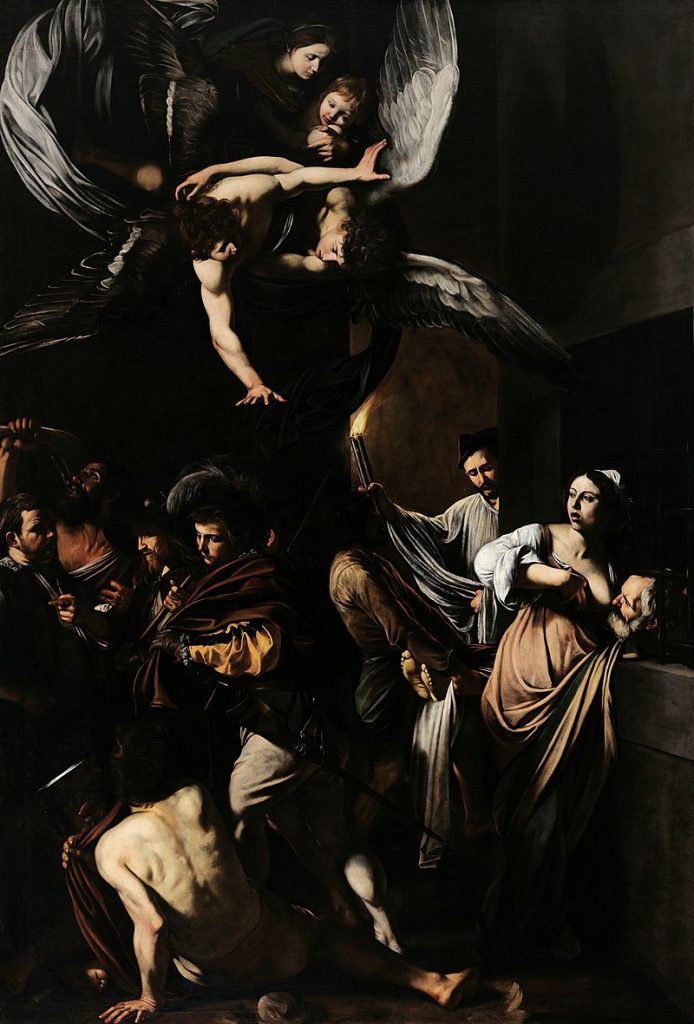
Caravaggio, The Seven Works of Mercy, 1607, Pio Monte della Misericordia, Naples, Italy.
He first went to Naples, where he knew he had the support and protection of the Colonna family. He immediately secured several major church commissions, including The Seven Works of Mercy, one of the most complex and ambitious canvases of his career.
However, Caravaggio did not stay in the city. Instead, he traveled to Malta, where he hoped to gain the support of the Knights of St John in his quest for a papal pardon. After briefly joining the Order, and gaining more commissions, including The Beheading of St John, the artist again became involved in violence. A brawl led to his imprisonment, expulsion from the Knights, and a dramatic escape from the island.
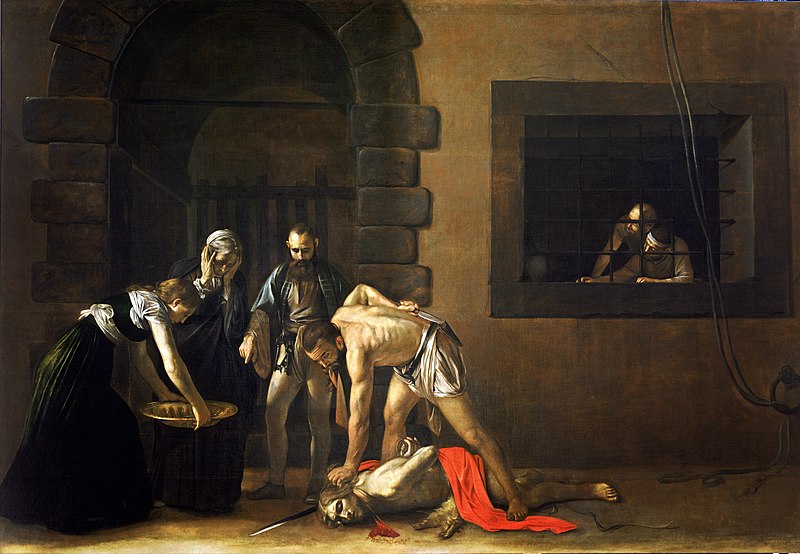
Caravaggio, The Beheading of St John, 1608, St John’s Co-Cathedral, Valetta, Malta.
After fleeing Malta, Caravaggio traveled to Sicily in late 1608. There, in a now familiar pattern, he combined bouts of intense productivity with erratic behavior and an increasing sense of paranoia. The St Lucy Altarpiece dates from his time in Sicily.
He returned to Naples in the late summer of 1609. Saint Ursula is one of relatively few works from this last period in the city. The artist was attacked in the street by four armed men shortly after his arrival. Caravaggio was injured, slashed across the face, and spent time recuperating. There were even rumors that he was dead.
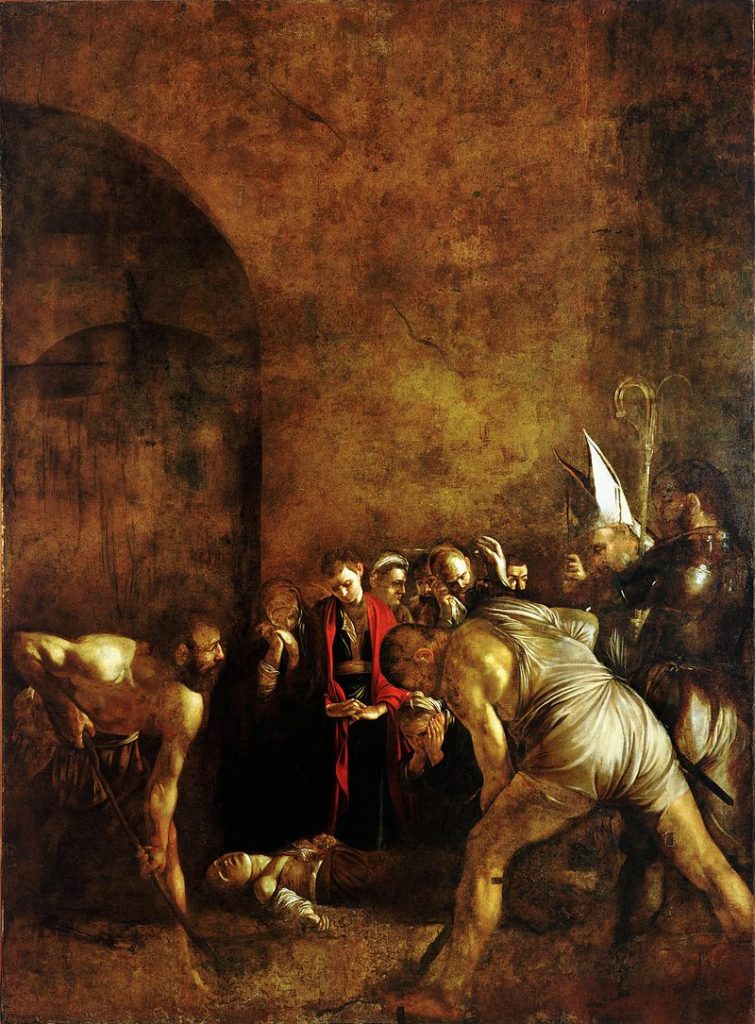
Caravaggio, The Burial of Saint Lucy, 1608, Church of Santa Lucia al Sepolcro, Syracuse, Italy.
In early 1610 Marcantonio Doria, a Genoese nobleman, commissioned a painting from Caravaggio, to celebrate his stepdaughter joining the Order of Saint Ursula. Doria was a major patron of the arts who owned works by Raphael and Leonardo da Vinci. He was also a long-standing supporter of Caravaggio.
The commission is well documented through letters between Doria and his agent in Naples. The painting is reported as finished on May 11th, and we know that it arrived in Genoa on June 18th, 1610.
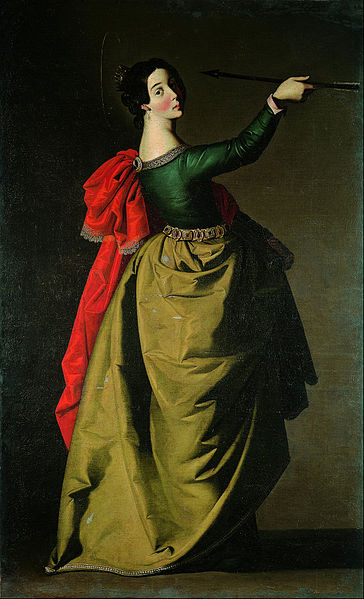
Francisco de Zurbaran, Saint Ursula, 1635-40, Musei di Strada Nuova, Genoa, Italy.
According to legend, Ursula was the daughter of a Christian king from Ancient Britain. She set out with up to 11,000 virgin attendants to marry the pagan governor of Armorica in France, who had agreed to convert to Christianity.
Whilst on a pre-wedding pilgrimage, she and her handmaidens were attacked by Huns at Cologne. The 11,000 women were beheaded, but Ursula was given the chance to save herself. The Hun leader, overcome by her beauty, offered her marriage. When she refused he shot her with an arrow.
Saint Ursula’s Basilica in Cologne was built on the site of the alleged mass grave of the Ursuline virgins and contains her remains. St Ursula’s feast day is October 21 and she has an Order of nuns named after her.
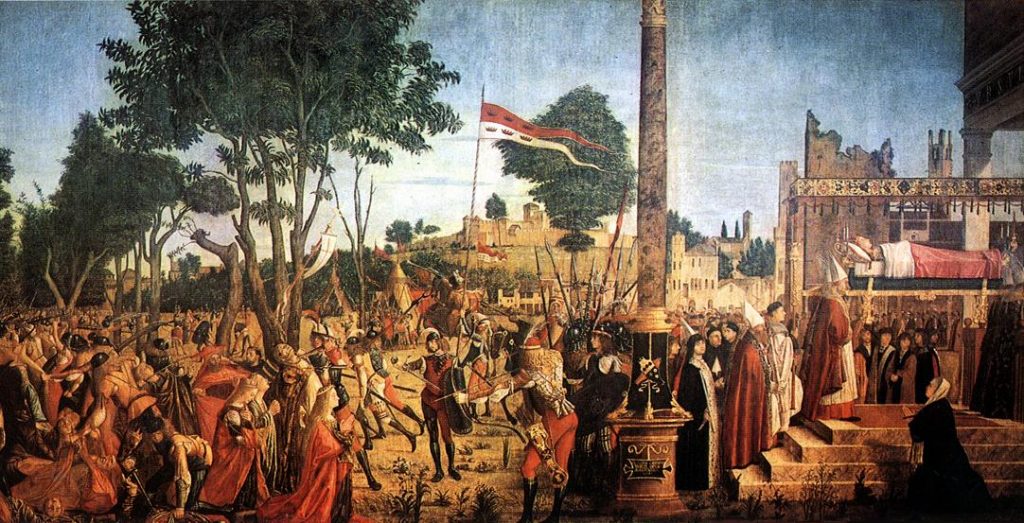
Vittore Carpaccio, The Martyrdom of the Pilgrims and the Funeral of St Ursula, 1493, Galleria dell ‘Accademia, Venice, Italy.
The story of St. Ursula had appealed to artists since the early Renaissance. She was usually represented, as in Francisco de Zurbaran’s 1635-40 version, as a single figure, with her attribute, the arrow of her martyrdom.
Other artists focused on the narrative potential of the legend, with cast-of-thousands panoramas. Most famously, Vittore Carpaccio completed a series of paintings telling the whole story from the first marriage arrangements to Ursula being received into heaven. His depiction of the massacre deliberately avoids showing the saint’s death. Instead, he cuts directly from her kneeling before her killer, to her funeral.
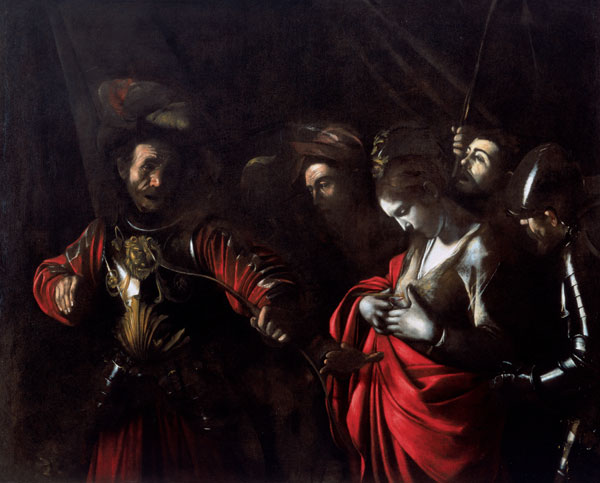
Caravaggio, The Martyrdom of Saint Ursula, 1610, Palazzo Zevallos Stigliano, Naples, Italy.
Caravaggio interprets the subject of St. Ursula quite differently. He chooses to show the arrow piercing the saint’s breast, a second of captured time, just as the blood starts to flow. The painting focuses on the reactions of the surrounding figures. The Hun ruler, who still holds the bow in his hand, seems almost regretful. The other men, some barely visible, express the shock and horror that viewers share. One thrusts a hand forward, dramatically fore-shortened, in a futile attempt to stop the killing.
Like the other works from Caravaggio’s last months in Naples, St. Ursula marks a shift in style. In Malta and Sicily, he had produced large, sparse compositions in which complex figure groups seem dwarfed by their surroundings. In part, this is because St. Ursula is a smaller, private commission, but it also seems a deliberate choice by the artist.
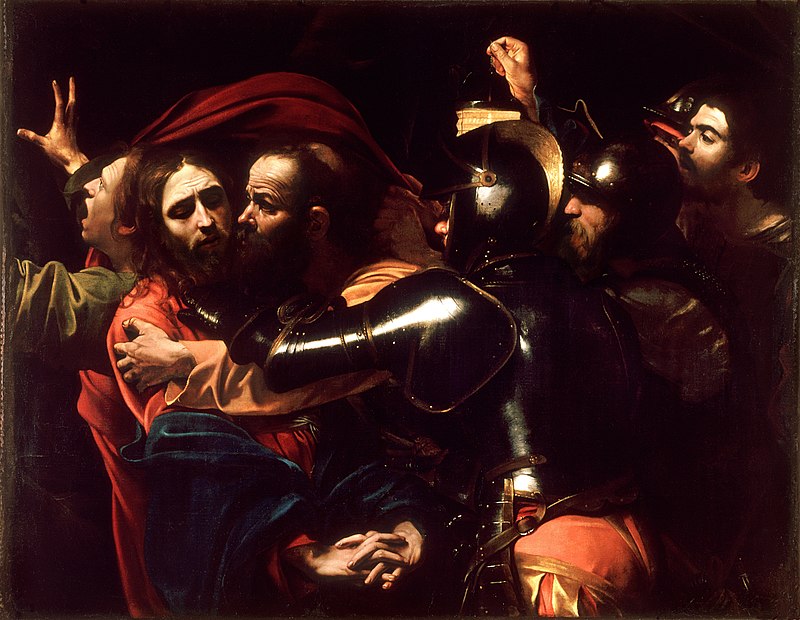
Caravaggio, The Taking of Christ, c.1602, National Gallery of Ireland, Dublin, Ireland.
In some ways, St. Ursula harks back to Caravaggio’s earlier works, like The Taking of Christ. In both, there is a claustrophobic, intertwined group of figures with exaggerated gestures and expressions, strong chiaroscuro contrasts, and a prominence of red and highly polished metal. However, the high drama of the early works is replaced by an eerie calm in St. Ursula.
The figure of the saint is almost statue-like, her pale skin foreshadowing her imminent death. The figures are arranged in a frieze, their heads in a line with clear space above. The center of the composition is empty, focused on the dark shadow between the two protagonists.
Most strikingly of all, is the sketchiness of parts of the painting. The arrow itself is barely there. The high finished precision of Caravaggio’s early career has been replaced by a looseness, which can also be seen in The Denial of St Peter, painted at the same time. The scenes are less stagey and contrived, and more like captured moments in time.
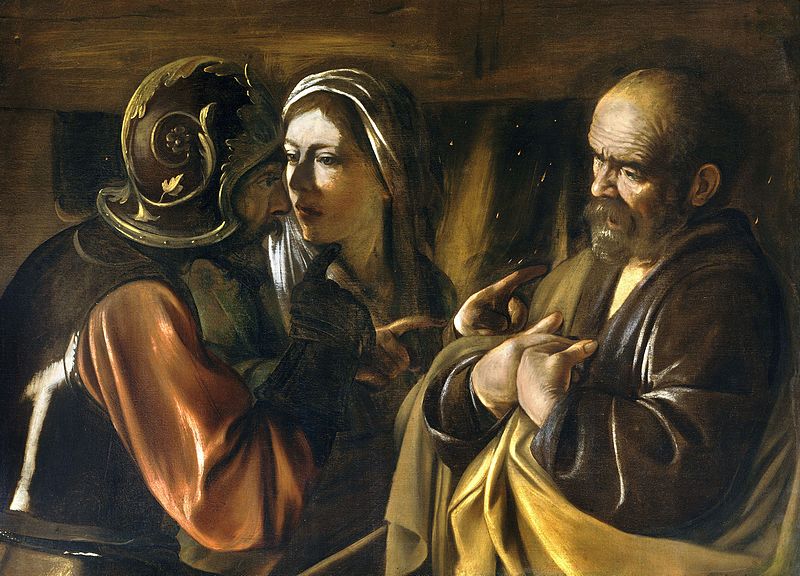
Caravaggio, 1610, The Denial of St Peter, Metropolitan Museum of Art, New York, NY, USA.
Many of Caravaggio’s works contain self-portraits. In St. Ursula, the clearly-lit, upturned face directly behind the saint is recognizable as the artist, mouth open in shock as he looks towards heaven. It is also an uncanny echo of his self portrait in the same position in The Taking of Christ.
By including himself in religious works, Caravaggio is asserting his own faith. There were also purely practical reasons: it was easier and cheaper to paint himself than to hire models and in Naples, with rumors of his death circulating, he was effectively declaring himself to be alive and well.
Most importantly, however, Caravaggio wanted his art to be seen as real. His protagonists are dressed in contemporary costume, his saints have no haloes. By including himself in the scene he is suggesting he is a witness, painting what he actually saw, what actually happened.
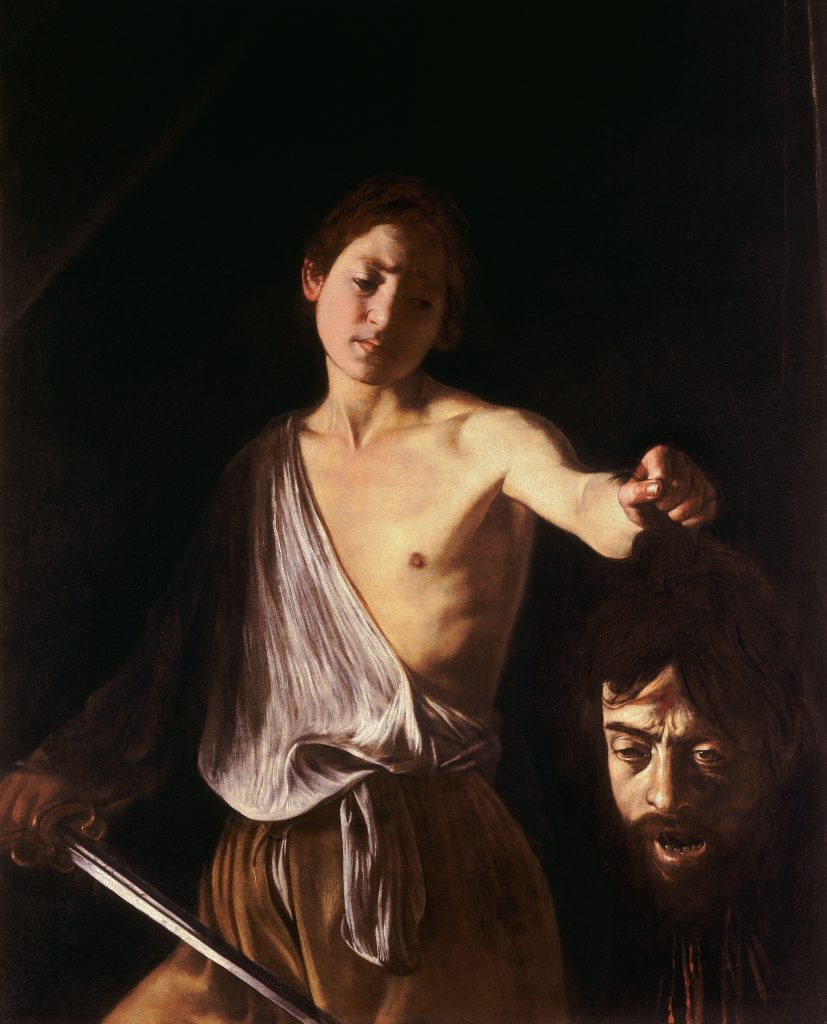
Caravaggio, David with the Head of Goliath, 1609-10, Borghese Gallery, Rome, Italy. Goliath is a self-portrait.
In July 1610 Caravaggio set off from Naples to Rome by boat, hopeful that he was finally to receive a papal pardon for the events of 1606. On board were three paintings that he intended to use as gifts – two of St. John the Baptist and one of Mary Magdalene. But he never got to Rome.
Caravaggio died from a fever at Porto Ercole, probably on July 18th. It seems likely that the attack the previous autumn had weakened him, perhaps there was residual infection which led to sepsis. Suggestions of syphilis, malaria, or even murder have been put forward. Whatever the cause, it was a sudden, tragic, and mysterious end to a life that had always been dramatic.
After his death, Caravaggio’s friend, Marzio Milesi, described his work as “not equal to a painter, but to Nature itself.” In The Martyrdom of Saint Ursula, he comes perhaps closer than ever to living up to that epitaph.
DailyArt Magazine needs your support. Every contribution, however big or small, is very valuable for our future. Thanks to it, we will be able to sustain and grow the Magazine. Thank you for your help!